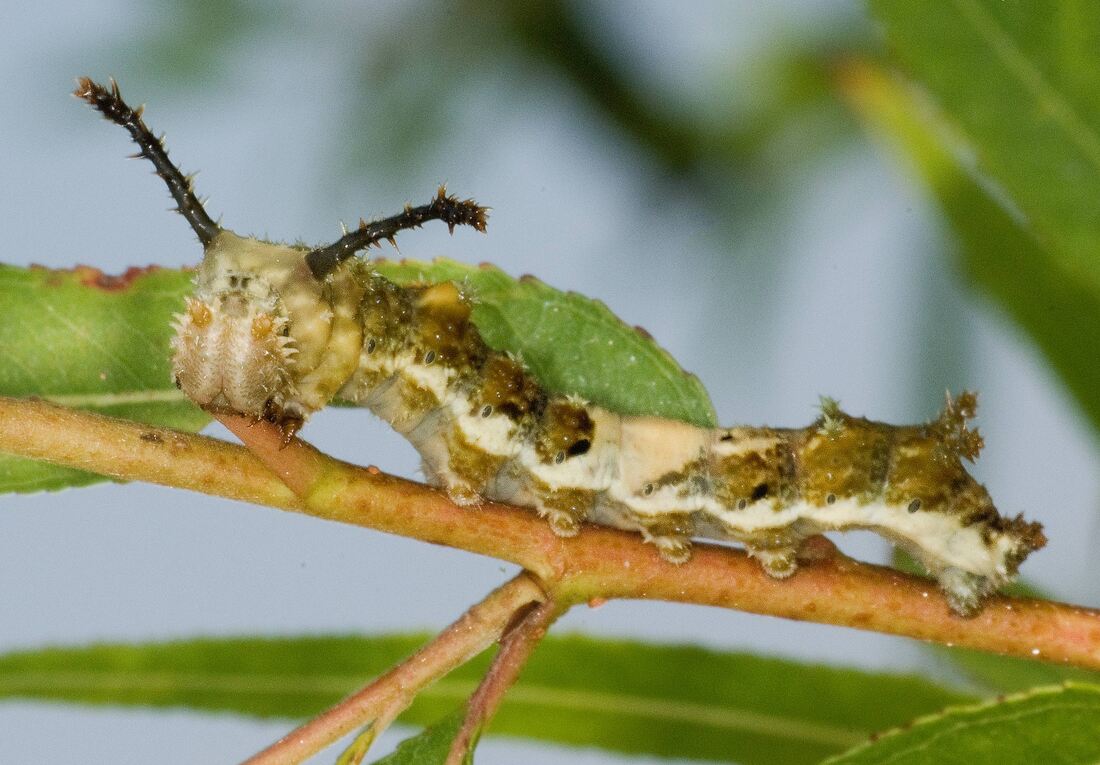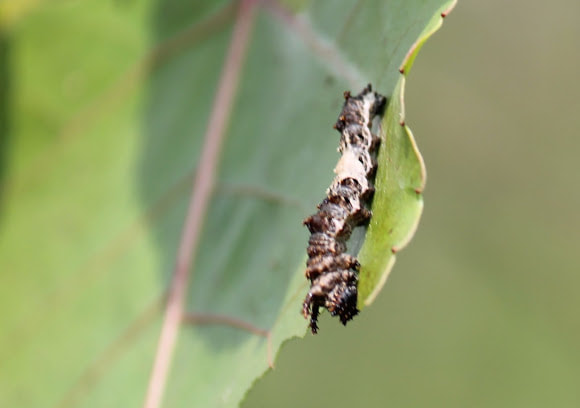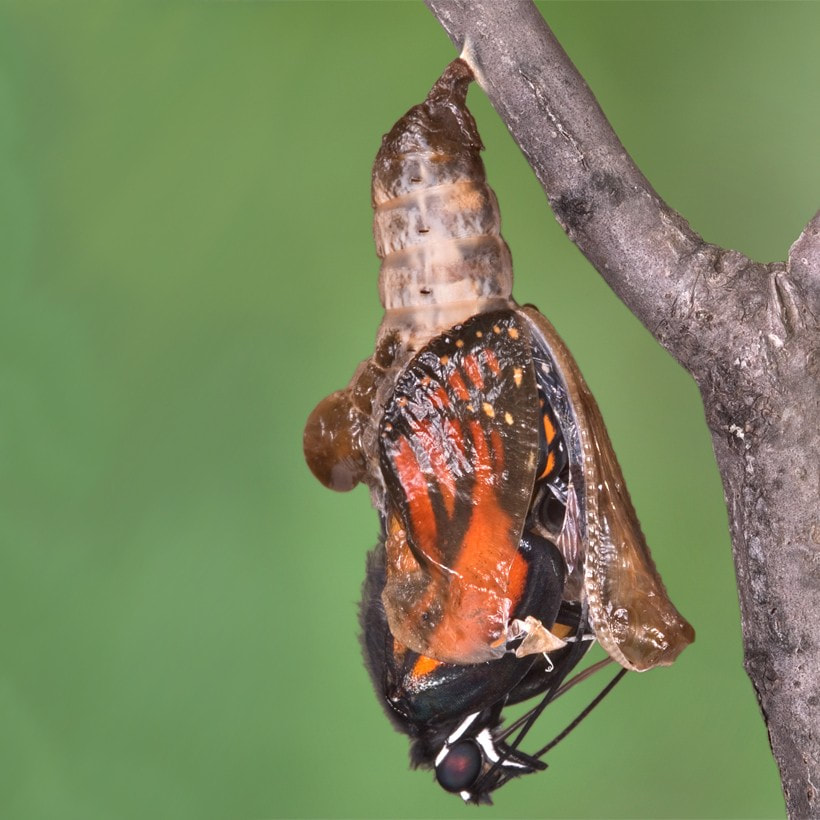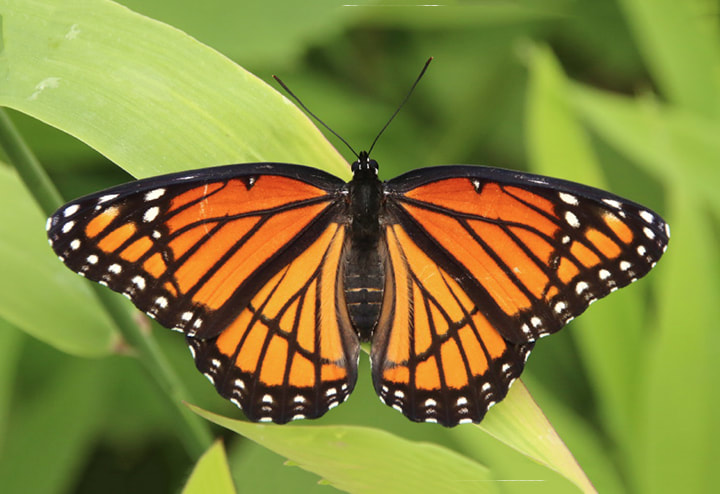Viceroy. Limenitis archippus.
|
The viceroy is an interesting creature that has a larval caterpillar form and an adult butterfly form. It is most commonly referred to as the viceroy butterfly, as that is the stage most recognizable to humans, but in fact the viceroy spends eight to ten of its twelve-month life as a caterpillar (About Animals). The caterpillar is green and brown, with white spots, and antennae on its head. The butterfly has a fuzzy black body and bright orange wings with black horizontal stripes. The butterfly's features also include a tube-like mouth part, antennae, and six legs: four functional in the back and two non-functional in the front (University of Kentucky).
|
The life cycle of the viceroy is similar to that of all butterflies. The adult female butterfly lays two to three eggs on a single leaf, which then becomes a food source for the larvae when they hatch. The central vein of the leaf is left untouched and used as a resting spot during the following months of hibernation. The viceroy caterpillar creates its own hibernaculum out of the remaining bits of the leaf, producing silk to secure it to the stem (The BugLady). In the spring, the caterpillars eat fresh leaves and continue their development (Sourakov). The viceroy then undergoes the chrysalis/pupa stage, during which it goes through complete metamorphosis and, after ten days, emerges as a butterfly. Almost immediately the adult butterflies begin the mating ritual; eggs are laid, the adults survive three to four weeks, and the cycle continues (About Animals).
|
The viceroy can be found throughout most of the continental United States, southern Canada, and Northern Mexico, where it lives in areas close to water (Nature Works). In fact, the genus name Limenitis comes from the Latin word for marshes, where Viceroys can often be found. In the marshes, the caterpillar larvae eat willows, poplars, and cottonwood leaves, while the butterflies eat decaying fruit, fungi, sap, feces, and nectar from flowers (University of Kentucky). Great care is taken by the female butterfly to lay eggs on a leaf that is uninfected by other insects and suitable for the developing larva to eat (About Animals).
|
|
Caterpillars spend most of their lives eating and preparing for the next stage, whether that be hibernation, pupal, or another larval caterpillar form. The adult female spends her time feeding and looking for a good place to lay eggs. The adult male is territorial; he can often be seen flying up and down to protect his area from another male butterfly. While mating, the male and female utilize a tail to tail method. They can fly while in this position, and since the female is slightly larger than the male it can often involve her pulling him around an area. Viceroys have sensory organs to help them look for food and detect mates, including eyes capable of detecting UV light and seeing in multiple directions at once. In addition, its feet and antennae have specialized organs that can detect whether or not a flower has nectar on it (About Animals). They can often be seen using these organs to sense their environment.
|
Perhaps the most interesting feature of the viceroy is its utilization of mimicry to avoid predators at each stage of its life. When the eggs are laid on a leaf, they resemble galls (Sourakov), or abnormal growths on the plant (The Mortem Arboretum). This can prevent other insects and organisms from eating/interacting with the leaf, thus protecting the eggs. Viceroy caterpillars mimic bird droppings, thus protecting themselves from birds and other predators such as snakes, frogs, and spiders (About Animals). Caterpillars of other species usually spend their time on the bottom of a leaf, to prevent desiccation and to hide from predators, but the viceroy stays on top of the leaf, where bird droppings would likely be found (Kautz). The chrysalis also tends to resemble a bird dropping hanging from the tip of a leaf (Adirondacks Forever Wild).The butterfly looks similar to other butterfly species, including the monarch and the queen. In fact, it got the common name viceroy because of this resemblance, as a viceroy is a royal who rules as a representative of a king, and the viceroy butterfly is slightly smaller than the monarch (Sourakov). Viceroys were once thought to utilize Batesian mimicry, where a palatable organism (the viceroy) mimics an unpalatable organism (the monarch) to avoid predation. However, it is now known they use Mullerian mimicry, where both species are unpalatable and mimic each other to avoid predation (Adirondacks Forever Wild). If a bird eats one unpalatable butterfly, it will then learn to avoid all orange and black looking butterflies, thus the species help each other.
|
Due to its mimetic abilities, the viceroy's main role in the ecosystem is to contribute to the protection of black and orange butterflies. It also acts as a pollinator, helping certain species of plants reproduce (Herridge). Although not threatened often by predators, the viceroy is facing issues with habitat destruction by humans. It is important to plant willows, poplars, and cottonwood trees around bodies of water, and to avoid using harsh pesticides on these plants, to help the viceroy thrive (University of Kentucky). If you live near a body of water in the United States, be sure to look out for the viceroy on your next nature walk and appreciate its unique beauty.
|
Sources
1. About Animals. Viceroy Butterfly: Deceiving the Birdseye. 2018, www.aboutanimals.com/insect/viceroy-butterfly/.
2. Adirondacks Forever Wild. “Butterflies of the Adirondacks: Viceroy (Limenitis Archippus).” Adirondack Butterflies: Viceroy | Limenitis Archippus), 2020, wildadirondacks.org/adirondack-butterflies-viceroy-limenitis-archippus.html.
3.The BugLady. Viceroy Butterfly Revisited (Family Nymphalidae). 11 Mar. 2017, uwm.edu/field-station/viceroy-butterfly-revisited/.
4. Herridge, Linda. Pollinators at Kennedy Space Center. 13 Mar. 2020, www.nasa.gov/feature/pollinators-at-kennedy-space-center.
5. Kautz, Liz. VICEROY. 23 May 2016, www.thecaterpillarlab.org/single-post/2016/05/23/VICEROY.
6. The Mortem Arboretum. Plant Galls. 2020, www.mortonarb.org/trees-plants/tree-and-plant-advice/help-pests/plant-galls.
7. Nature Works. Viceroy Butterfly - Limenitis Archippus - NatureWorks. 2020, www.nhptv.org/natureworks/viceroy.htm.
8. Sourakov, Andrei. Common Name: Viceroy Butterfly Scientific Name: Limenitis Archippus (Cramer) (Lepidoptera: Nymphalidae: Limenitidinae). Aug. 2015, entnemdept.ufl.edu/creatures/bfly/viceroy.htm.
9. University of Kentucky. Viceroy Butterfly. oepos.ca.uky.edu/content/viceroy-butterfly.
Images
1.Bright, Sara. “Viceroy (Limenitis Archippus).” Alabama Butterfly Atlas, 15 Sept. 2005, alabama.butterflyatlas.usf.edu/species/details/91/viceroy.
2. Charney, Vitaly. “Viceroy (Limenitis Archippus).” Alabama Butterfly Atlas, 28 June 2014, alabama.butterflyatlas.usf.edu/species/details/91/viceroy.
3. “Viceroy Butterfly Chrysalis.” Butterfly Identification, 2020, www.butterflyidentification.com/viceroy.htm.
4. Whipkey, Anna. “Viceroy Butterfly Caterpillar.” Project Noah, 9 Aug. 2011, www.projectnoah.org/spottings/7010028.
2. Adirondacks Forever Wild. “Butterflies of the Adirondacks: Viceroy (Limenitis Archippus).” Adirondack Butterflies: Viceroy | Limenitis Archippus), 2020, wildadirondacks.org/adirondack-butterflies-viceroy-limenitis-archippus.html.
3.The BugLady. Viceroy Butterfly Revisited (Family Nymphalidae). 11 Mar. 2017, uwm.edu/field-station/viceroy-butterfly-revisited/.
4. Herridge, Linda. Pollinators at Kennedy Space Center. 13 Mar. 2020, www.nasa.gov/feature/pollinators-at-kennedy-space-center.
5. Kautz, Liz. VICEROY. 23 May 2016, www.thecaterpillarlab.org/single-post/2016/05/23/VICEROY.
6. The Mortem Arboretum. Plant Galls. 2020, www.mortonarb.org/trees-plants/tree-and-plant-advice/help-pests/plant-galls.
7. Nature Works. Viceroy Butterfly - Limenitis Archippus - NatureWorks. 2020, www.nhptv.org/natureworks/viceroy.htm.
8. Sourakov, Andrei. Common Name: Viceroy Butterfly Scientific Name: Limenitis Archippus (Cramer) (Lepidoptera: Nymphalidae: Limenitidinae). Aug. 2015, entnemdept.ufl.edu/creatures/bfly/viceroy.htm.
9. University of Kentucky. Viceroy Butterfly. oepos.ca.uky.edu/content/viceroy-butterfly.
Images
1.Bright, Sara. “Viceroy (Limenitis Archippus).” Alabama Butterfly Atlas, 15 Sept. 2005, alabama.butterflyatlas.usf.edu/species/details/91/viceroy.
2. Charney, Vitaly. “Viceroy (Limenitis Archippus).” Alabama Butterfly Atlas, 28 June 2014, alabama.butterflyatlas.usf.edu/species/details/91/viceroy.
3. “Viceroy Butterfly Chrysalis.” Butterfly Identification, 2020, www.butterflyidentification.com/viceroy.htm.
4. Whipkey, Anna. “Viceroy Butterfly Caterpillar.” Project Noah, 9 Aug. 2011, www.projectnoah.org/spottings/7010028.




